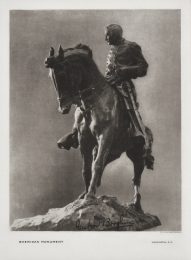

Paul Delvaux (1897-1994) was a Belgian painter noted for his dream-like scenes of women, classical architecture, trains and train stations, and skeletons, often in combination. He is often considered a surrealist, although he only briefly identified with the Surrealist movement.
Nude Figures
The recurring presence of nude or partially clothed figures in Delvaux’s paintings and prints is a central theme. These figures often appear in dreamlike or mythological settings, serving as symbols of beauty, vulnerability, and sensuality. The classical and idealised nature of these figures emphasises their timeless and archetypal qualities.
Classical Architecture
Delvaux frequently incorporated classical architectural elements into his works, such as columns, arches, and ruins. These structures evoke a sense of timelessness and often act as a backdrop for his enigmatic scenes. The juxtaposition of classical architecture with modern elements contributes to the surreal and dreamy atmosphere of his compositions.
Skeletons
Skeletons are symbolic of mortality and the passage of time. Delvaux often included skeletons in his works, sometimes interacting with the living figures. This juxtaposition creates a sense of contrast between life and death, inviting viewers to contemplate the transience of human existence.
Trains
Trains are recurring motifs in Delvaux’s art, symbolising the modern industrial age and the concept of journey or passage. The train may represent the relentless march of time or the inevitable progression of life, sometimes suggesting a sense of foreboding or existential contemplation.
Masks and Doppelgängers
Delvaux occasionally depicted figures wearing masks or having multiple faces, exploring the theme of identity and hidden truths. This use of masks can represent the concealment of one’s true self or the layers of personas that individuals may adopt in society.
Moon and Celestial Bodies
The moon and celestial bodies often appear in Delvaux’s nocturnal scenes, casting a surreal and eerie light. These elements contribute to the dreamlike quality of his art and may symbolise mystery, the subconscious, or the influence of the cosmos on human experience.
Mannequins and Dolls
Delvaux frequently painted mannequin-like figures, which can be seen as representations of artificiality or conformity. These figures may symbolise societal expectations, conformity, or the dehumanising effects of modern life.
Mirrors
Mirrors are sometimes used in Delvaux’s works, reflecting the theme of self-reflection and introspection. Mirrors can represent the inner psyche, the unconscious, or the duality of human nature.